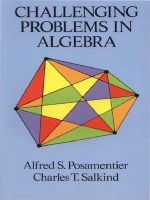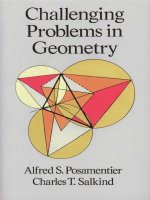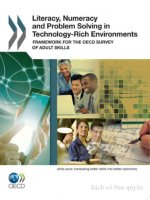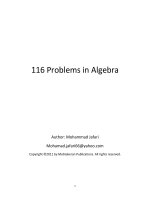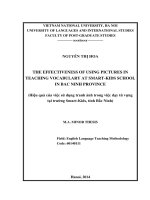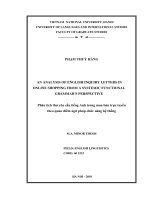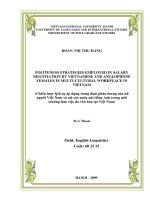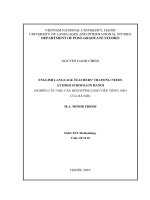Challenging problems in algebra 2e (dover) posamentier & salkind
Bạn đang xem bản rút gọn của tài liệu. Xem và tải ngay bản đầy đủ của tài liệu tại đây (8.43 MB, 273 trang )
Challenging Problems
in
Algebra
ALFRED S. POSAMENTIER
Professor
of
Mathematics Education
The City College
of
the City University
of
New
York
CHARLES
T.
SALKIND
Late Professor
of
Mathematics
Polytechnic University, New
York
DOVER PUBLICATIONS, INC.
New
York
Copyright
Copyright © 1970, 1988 by Alfred S. Posamentier.
All
rights
reserved
under
Pan
American
and International Copyright
Conventions.
Published
in
Canada by General Publishing Company, Ltd., 30 Lesmill Road,
Don Mills, Toronto,
Onlano.
Published
in
the United Kingdom by Constable and Company, Ltd., 3 The
Lanchesters, 162-164 Fulham Palace Road. London W6 9ER.
Bibliographical Note
This Dover edition, first published
in
1996, is
an
unabridged. very slightly
altered republication
of
the work first published
in
1970
by
the Macmillan Com-
pany,
New York. and again
in
1988 by Dale Seymour Publications. Palo Alto.
California For the Dover edition, Professor Posamentier has made two slight
alterations
in
the introductory material.
Library
of
Congress Cataloging-in-Publication Data
Posamentier. Alfred S.
Challenging problems
in
algebra! Alfred S. Posamentier, Charles T Salkind
p.
cm.
"An unabridged, very slightly altered republication
of
the work first published
in
1970 by the Macmillan Company,
New
York. and again in
1988
by Dale
Seymour Publications, Palo Alto, California. For the Dover edition, Professor
Posamentier has made two slight alterations in the introductory
material"
-T.p
verso.
ISBN
0-486-69148-9 (pbk )
I.
Algebra-Problems,
exercises,
etc
I
Salkind.
Charles
T .•
1898
II. Title.
QAI57.P68 1996
512.9'076-dc20
95-48215
CIP
Manufactured in the United States
of
Amenca
Dover Publications, Inc.,
31
East 2nd Street. Mineola.
N.Y.
11501
CONTENTS
Introduction iv
Preparing to
Solve a Problem viii
SECTION
I
First
Year
Algebra
Problems Solutions
1.
Posers: Innocent and Sophisticated 1
65
2. Arithmetic: Mean and Otherwise
6
74
3.
Relations: Familiar and
Surprising
10 84
4. Bases: Binary and Beyond 14
92
5.
Equations, Inequations, and Pitfalls
17
99
6. Correspondence: Functionally Speaking 22
111
7.
Equations and Inequations:
Traveling in Groups 25
121
8. Miscellaneous: Curiosity Cases 27
131
SECTION
II
Second
Year
Algebra
9. Diophantine Equations:
The Whole Answer
30
139
10. Functions: A Correspondence Course
32 146
11. Inequalities, More
or
Less
35 152
12. Number Theory: Divide and Conquer
37 159
13. Maxima and Minima:
Ups and Downs 41
173
14. Quadratic Equations: Fair and
Square
43 180
15.
Systems
of
Equations:
Strictly Simultaneous 45
185
16. Algebra and Geometry:
Often the Twain
Shall Meet
47
191
17. Sequences and Series:
Progression Procession
51
201
18. Logarithms: A Power Play
57
220
19. Combinations
and
Probability:
Choices and Chances
58 222
20. An Algebraic Potpourri
61
229
Answers
240
Appendices
254
INTRODUCTION
The
challenge
of
well-posed problems transcends national boundaries,
ethnic origins, political systems, economic doctrines, and religious
beliefs; the appeal is almost universal. Why?
You are invited to formulate
your
own
explanation.
We
simply accept the observation and exploit it
here for entertainment
and enrichment
This
book
is
anew,
combined edition
of
two volumes
fIrSt
published
in
1970.
It
contains more than three hundred problems that are "off the
beaten
path"-problems
that give a new twist to familiar topics or that
introduce unfamiliar topics. With few exceptions, their solution requires
little more than some knowledge
of
elementary algebra, though a dash
of
ingenuity
may
help. The problems range from fairly easy to hard, and
many
have
extensions
or
variations that we call challenges. Supplied
with pencil
and
paper
and
fortified with a diligent attitude, you can make
this material the starting point for exploring unfamiliar or little-known
aspects
of
mathematics. The challenges will spur you on; perhaps you can
even supply your own challenges in some cases. A study
of
these non-
routine problems can provide valuable underpinnings for work in more
advanced mathematics.
This book. with slight modifications
made, is as appropriate
now
as
it
was a quarter century ago when
it
was
first published. The National Council
of
Teachers of Mathematics (NCTM),
in
their Curriculum and Evaluation
Standards for
High School Mathematics (1989), lists problem solving as its
first standard, stating that "mathematical problem solving
in
its broadest
sense is nearly synonymous with doing mathematics." They go on to
say,
"[problem solving] is a process by which the fabric
of
mathematics is
identified in later standards as both constructive and reinforced.
to
This strong emphasis on mathematics is by
no
means a
new
agenda
item. In
1980, the NCTM published An Agendafor Action. There. the NCTM
also had problem solving as its first item, stating, "educators should give
priority to the identification and analysis of specific problem solving strate-
gies
[and] should develop and disseminate examples of 'good problems'
and strategies."
It
is our intention to provide secondary mathematics
educators with materials to help them implement this very important
recommendation.
v
ABOUT
THE
BOOK
Challenging Problems in Algebra is organized into three main parts:
"Problems," "Solutions," and "Answers."
Unlike many contemporary
problem-solving resources. this book is arranged
not by problem-solving
technique, but by topic. We feel that announcing the technique to
be
used
stifles creativity and destroys a good part
of
the fun
of
problem solving.
The problems themselves are grouped into two sections. Section I
covers eight topics that roughly parallel the sequence
of
a fust year
algebra course. Section II presents twelve topics that roughly parallel the
second year algebra course.
Within each topic, the problems are arranged
in
approximate order
of
difficulty. For some problems, the basic difficulty may lie in making the
distinction between relevant and irrelevant data or between known and
unknown information. The sure ability to make these distinctions is part
of
the process
of
problem solving, and each devotee must develop this
power by him- or herself. It will come with sustained effort.
In
the "Solutions" part
of
the book, each problem is restated and then
its solution is given. From time to time
we
give alternate methods
of
solution, for there
is
rarely only one way to solve a problem. The
solutions shown are far from exhaustive. and intentionally so, allowing
you to try a variety
of
different approaches. Particularly enlightening is
the strategy
of
using multiple methods. integrating algebra, geometry. and
trigonometry. Instances
of
multiple methods or multiple interpretations
appear
in
the solutions. Our continuing challenge to you, the reader. is to
fmd a different method
of
solution for every problem.
The third part
of
the book, "Answers," has a double purpose.
It
contains the answers to all problems and challenges, providing a quick
check when you have arrived
at
a solution. Without giving away the
entire solution, these answers can also give
you
a hint about how to
proceed
when
you
are stuck.
Appendices
at
the end
of
the book provide information about several
specialized topics that are not usually covered
in
the regular curriculum
but are occasionally referred to in the solutions. This material should be
of
particular interest and merits special attention at the appropriate time.
THE
TOPICS COVERED
Section
I.
The book begins with a chapter
of
general problems,
simple to state and understand, that are generally appealing
to
students. These should serve as a pleasant introduction to
problem
solving early in the elementary algebra course.
Chapter 2 demonstrates the true value
of
algebra in understanding
arithmetic phenomena. With the use
of
algebraic methods, students
are
guided through fascinating investigations
of
arithmetic curiosities.
vi
Familiar
and
unfamiliar relations are the bases for
some
cute
problems
in
chapter
3.
A refreshing consideration
of
various
base
systems
is
offered
in
chapter
4.
Uncommon
problems dealing with the
common
topics
of
equations,
inequalities,
functions,
and
simultaneous
equations
and
inequalities
are
presented
along
with
stimulating
challenges in chapters
5,
6,
and
7.
The
last chapter
of
this section contains a collection
of
problems
summarizing the techniques encountered earlier. These problems are best
saved for the
end
of
the elementary algebra course.
Section
II.
The
second section
opens
with a chapter
on
one
of
the
oldest forms
of
algebra, Diophantine
equations-indeterminate
equations
for which only integer solutions are sought. These problems often appear
formidable to the young algebra student,
yet
they can
be
solved easily
after some experience with the type (which this section offers).
The
next
two
chapters present
some
variations
on
familiar themes,
functions and inequalities, treated here in a more sophisticated manner
than was employed in the first section.
The
field
of
number theory includes some interesting topics for the
secondary school student, but all too often this area
of
study
is
avoided.
Chapter 12 presents some
of
these concepts through a collection
of
unusual problems. Naturally, an algebraic approach is used throughout.
Aside from a
brief
exposure to maxium and minimum points
on
a
parabola, very little is done with these concepts prior to a study
of
the
calculus.
Chapter
13 will demonstrate through problem solving
some
explorations
of
these concepts
at
a relatively elementary level.
Chapters
14, 15, 17, and 18 offer unconventional problems for
some
standard topics: quadratic equations, simultaneous equations, series, and
logarithms.
The
topic
of
logarithms
is
presented in this book
as
an
end
in
itself rather than
as
a (computational) means to an end, which has been its
usual role. Problems in these chapters should shed some new (and dare we
say refreshing) light
on
these familiar topics.
Chapter
16
atlempts to bring
some
new
life
and
meaning,
via
problem solving, to analytic geometry. Chapter 19 should
serve
as a
motivator for further study
of
probability
and
a consideration
of
general
counting techniques.
We
conclude
our
treatment
of
problem solving in algebra with
chapter
20, "An Algebraic Potpourri.
1t
Here
we
attempt to pull together
some
of
the
problems and solution techniques considered in
earlier
sections. These final problems are quite challenging
as
well
as
out
of
the
ordinary,
even
though the topics from which they are drawn are
quite
familiar.
vii
USING
THE
BOOK
This book may be used in a variety
of
ways. It is a valuable supplement
to the basic algebra textbooks, both for further explorations on specific
topics and for practice in developing problem-solving techniques. The
book also has a natural place in preparing individuals or student
teams for
participation in mathematics contests. Mathematics clubs might use this
book as a source
of
independent projects or activities. Whatever the use,
experience has shown that these problems motivate people
of
all ages to
pursue more vigorously the study
of
mathematics.
Very near the completion
of
the first phase
of
this project, the
passing
of
Professor Charles
T.
Salkind grieved the many who knew and
respected him. He dedicated much
of
his life to the study
of
problem
posing and problem solving and to projects aimed at making problem
solving meaningful, interesting, and instructive to mathematics students
at all levels. His efforts were praised by all. Working closely with this
truly great man was a fascinating and pleasurable experience.
Alfred
S.
Posamentier
1996
PREPARING
TO
SOLVE A PROBLEM
A strategy for attacking a problem is frequently dictated
by
the use
of
analogy.
In
fact. searching for an analogue appears to
be
a psychological
necessity.
However.
some
analogues
are
more
apparent than real.
so
analogies should
be
scrutinized with care. Allied
to
analogy is structural
similarity
or
pattern.
Identifying
a pattern in apparently unrelated
problems is
not
a
common
achievement.
but
when done successfully
it
brings immense satisfaction.
Failure
to solve a problem
is
sometimes the result
of
fixed habits
of
thought. that is. inflexible approaches. When familiar approaches prove
fruitless.
be
prepared
to
alter the line
of
attack. A flexible attitude may
help you
to
avoid needless frustration.
Here are three ways
to
make a problem yield dividends:
(1)
The
result
of
formal manipulation, that is, "the answer,"
mayor
may
not
be
meaningful; find out! Investigate the possibility that
the
answer is
not
unique.
If
more than
one
answer is obtained. decide
on
the acceptabiklity
of
each alternatibe. Where appropriate, estimate the
answer in advance
of
the solution.
The
habit
of
estimating in advance
should help
to
prevent crude errors in manipUlation.
(2)
Check
possible restrictions
on
the data and/or the results. Vary the
data in significant ways
and
study the effect
of
such variations on the
original
result
(3)
The
insight
needed
to
solve a generalized problem
is
sometimes
gained
by
first specializing it. Conversely, a specialized problem,
difficult when tackled directly. sometimes yields to an easy solution
by
first generalizing it.
As
is
often true. there may
be
more than one way
to
solve a problem.
There is usually what
we
will refer
to
as
the "peasant's way" in contrast
to
the "poet's way
"-the
latter being the more elegant method.
To
better understand this distinction, let us consider the following
problem:
If
the
sum
of
two numbers is 2.
and
the product
of
these
same two numbers is
3,
find the sum
of
the reciprocals
of
these two numbers.
ix
Those attempting
to
solve the following pair
of
equations simultane-
ouslyare embarking on the
"peasant's way" to solve this problem.
x + y = 2
xy
= 3
Substituting for y in the second equation yields the quadratic equation,
xl -
2x
+ 3 =
O.
Using the quadratic formula
we
can find x = 1 ± i
J2.
By adding the reciprocals
of
these two values
of
x, the answer
~appears.
This is clearly a rather laborious procedure, not particularly elegant.
The "poet's
way" involves working backwards. By considering the
desired result
I 1
-+-
x y
and seeking an expression from which this sum may be derived, one
should inspect
the
algebraic sum:
! :!: l
xy
The answer to the original problem is now obvious! That is, since
x + y = 2 and
xy
= 3, x
;;
Y
~.
This
is
clearly a more elegant
solution than the first one.
The
"poet's way" solution to this problem points out a very useful
and all
too often neglected method
of
solution. A reverse strategy is
certainly not new. It was considered by Pappus
of
Alexandria about 320
A.D.
In Book VII
of
Pappus' Collection there is a rather complete descrip-
tion
of
the methods
of
"analysis" and "synthesis." T. L. Heath, in his
book
A Manual
of
Greek Mathematics (Oxford University Press, 1931,
pp. 452-53), provides a translation
of
Pappus' definitions
of
these terms:
Analysis
takes that which is sought as
if
it were
admitted and passes from it through its successive
consequences to something which is admitted as the
result
of
synthesis: for in analysis we assume that
which is sought as
if
it were already done, and we
inquire what it
is
from
which this results, and again
what is the antecedent cause
of
the latter, and so on,
until, by so retracing our steps, we come upon
something already known
or
belonging to the class
of
first principles, and such a method we call analysis as
being solution backward.
x
But in synthesis, reversing the progress, we take
as
already done that which was last arrived
at
in the
analysis and,
by
arranging in their natural order as
consequences
what
before
were antecedents, and
successively connecting them one with another, we
arrive finally
at
the construction
of
that which was
sought: and this we call
synthesis.
Unfortunately, this method has not received its due emphasis in the
mathematics classroom.
We
hope that the strategy recalled here will serve
you well in solving some
of
the problems presented in this book.
Naturally, there are numerous other clever problem-solving strategies
to pick from. In recent years a plethora
of
books describing various
problem-solving methods have become available. A concise description
of
these problem-solving strategies can be found in Teaching Secondary
School Mathematics: Techniques and Enrichment
Units, by
A.
S.
Posamentier and
1.
Stepelman, 4th edition (Columbus, Ohio: Prentice
Hall/Merrill, 1995).
Our
aim in this book is to strengthen the reader's problem-solving
skills through nonroutine motivational examples.
We
therefore allow the
reader the fun
of
finding the
best
path to a problem's solution, an
achievement generating the most pleasure
in
mathematics.
PROBLEMS
SECTION I
First Year Algebra
1.
Posers: Innocent and Sophisticated
The number
of
hairs on a human head, a castaway on a desert
island trying to conserve his supply
of
water, a stubborn watch
that
stops for fifteen minutes every hour - these are some
of
the fanciful
settings for the problems in this opening section. A variety
of
mathe-
matical ideas are encountered in the problems, with the Pigeon Hole
Principle and the mathematics
of
uniform motion receiving the greatest
share
of
attention.
I-I
Suppose there are 6 pairs
of
blue socks all alike, and 6 pairs
of
black socks all alike, scrambled
in
a drawer. How many socks
must be drawn out, all
at
once (in the dark),
to
be certain
of
getting a matching pair?
Challenge I Suppose the drawer contains 3 black pairs
of
socks, 7
green pairs, and 4 blue pairs, scrambled. How many socks
must be drawn out, all
at
once (in the dark),
to
be certain
of
getting a matching pair?
Challenge 2 Suppose there are 6 different pairs
of
cuff links scrambled
in a box. How many links must be drawn out, all
at
once
(in the dark),
to
be certain
of
getting a matching pair?
1-2 Find
five
positive whole numbers a,
b,
c,
d,
e such
that
there
is
no
subset with a sum divisible by
5.
1-3 A multiple dwelling has
50
letter boxes.
If
101
pieces
of
mail are
correctly delivered and boxed, show
that
there is
at
least one
letter box with 3 or more pieces
of
mail.
2 PROBLEMS
Challenge 1
What
conclusion follows
if
there are
102
pieces
of
mail?
Challenge 2
What
conclusion follows
if
there are 150 pieces
of
mail?
Challenge 3 What conclusion follows
if
there are
151
pieces
of
mail?
Challenge 4
If
no
human being has more than 300,000 hairs on his
head, and
the
population
of
Megalopolis
is
8,000,000
persons, what
is
the least value
of
n in the assertion that
there are
n persons in Megalopolis with the same number
of
hairs on their heads? (Assume that all people have
at
least one hair on their head.)
1-4 Assume
that
at
least one
of
al
and b
i
has property
P,
and
at
least one
of
a2
and b
2
has property
P,
and
at
least one
of
a3 and
b
3
has property
P.
Prove
that
at
least two
of
at.
a2, a3, or
at
least two
of
b
h
b
2
,
b
3
have property
P.
Challenge 1 Add
to
the information in Problem
1-4
that
at
least one
of
a4
and b
4
has property P, and
that
at
least one
of
a5 and b
5
has property
P.
Prove
that
at
least 3
of
the
a's,
or
at
least 3
of
the b's have property
P.
Challenge 2 Assume
that
property Q is possessed by
at
least one
of
ah
b
h
Ct. by
at
least one
of
a2, b
2
,
C2,
, by
at
least
one
of
a 1
0,
b 1
0,
C 1
o.
Find the largest value
of
k in the
assertion
that
at
least k
of
the a's,
or
at
least k
of
the b's,
or
at
least k
of
the c's have property
Q.
Challenge 3 Assume
that
property R is possessed
by
at
least two
of
aI.
bI.
Ch
by
at
least two
of
a2, b
2
,
C2,
,
by
at
least
two
of
a5, b
5
,
C5'
Find
the
largest value
of
m for which it
can be said
that
at
least m
of
the a's, or
of
the b's,
or
of
the c's have property
R.
1-5 An airplane flies round trip a distance
of
L miles each way. The
velocity with head wind is
160
m.p.h., while the velocity with tail
wind is
240 m.p.h.
What
is
the average speed for the round trip?
1-6 Assume
that
the trains between New York and Washington leave
each city every
hour
on the hour.
On
its run from Washington
to
New York, a train will meet n trains going in the opposite direc-
tion.
If
the one-way trip in either direction requires four hours
exactly, what is
the
value
of
n?
Posers: Innocent and Sophisticated 3
Challenge Change
"four
hours
exactly"
to
"three
and
one-half
hours
exactly"
and
solve the problem.
1-7 A freight
train
one
mile long is traveling
at
a steady speed
of
20 miles
per
hour.
It
enters
a tunnel
one
mile long
at
1
P.M.
At
what time does
the
rear
of
the
train
emerge from
the
tunnel?
1-8 A watch is stopped for
15
minutes every
hour
on
the hour.
How
many actual hours elapse
during
the interval the watch shows
12
noon
to
12
midnight?
Challenge
1 A watch is stopped for
15
minutes every
hour
on
the
hour. According
to
this watch, how many
hours
elapse
between
12
noon
and
12
midnight (actual time)?
Challenge 2 Between
12
noon
and
12
midnight, a watch is stopped for
I minute
at
the
end
of
the first full hour, for 2 minutes
at
the
end
of
the second full hour, for 3 minutes
at
the
end
of
the third full hour,
and
so forth for the remaining full
hours.
What
is
the
true time when this watch shows
12
midnight?
1-9
The
last
three
digits
of
a
number
N
are
x25.
For
how
many
values
of
x can N be
the
square
of
an
integer?
1-10 A man
born
in
the
eighteenth century was x years old in
the
year x
2
•
How
old was he in 1776?
(Make
no
correction for
calendric changes.)
Challenge
1 Is there a corresponding puzzle for
the
nineteenth cen-
tury?
If
so, find
the
man's
age in 1876.
Challenge 2
Show
that
there
is
no
corresponding puzzle for
the
twentieth century.
1-11
To
conserve
the
contents
of
a 16 oz.
bottle
of
tonic, a castaway
adopts
the following procedure.
On
the
first day he
drinks
I oz.
of
tonic
and
then refills
the
bottle
with
water;
on
the
second day
he drinks 2 oz.
of
the mixture
and
then
refills
the
bottle
with
water;
on
the
third
day
he drinks 3 oz.
of
the
mixture
and
again
refills
the
bottle with water.
The
procedure is continued for suc-
ceeding days
until
the
bottle
is empty.
How
many
ounces
of
water
does he
thus
drink?
4
PROBLEMS
Challenge Assume
that
the castaway drinks only
~
oz. the first day,
t oz. the second day,
l~
oz. the third day, and so forth.
Find the total consumption
of
water.
1-12 Which yields a larger amount with the same starting salary:
Plan I, with four annual increases
of
$100 each,
or
Plan II, with two biennial increases
of
$200 each?
Challenge How does the result change if the increase under
Plan II
is
$250?
1-13 Assuming
that
in a group
of
n people any acquaintances are
mutual, prove
that
there are two persons with the same number
of
acquaintances.
1-14 The smallest
of
n consecutive integers
isj.
Represent in terms
of
j
(a) the largest integer L (b) the middle integer
M.
Challenge 1 Let j be the largest
of
n consecutive integers. Represent
in terms
of
j (a) the smallest integer S (b) the middle
integer
M.
Challenge 2 Let j be the smallest
of
n consecutive even integers.
Represent
in
terms
of
j (a)
the
largest integer L (b) the
middle integer
M.
Challenge 3 Let j be the smallest
of
n consecutive odd integers.
Represent in terms
of
j (a) the largest integer L (b) the
middle integer
M.
Challenge 4
If
n
is
a multiple
of
4, find
the
integer in position
3;
for the original problem and each
of
Challenges I,
2,
and
3.
I-IS
We define
the
symbollxl
to
mean the value x
if
x
~
0, and the
value
-x
if
x <
O.
Express
Ix
-
yl
in terms
of
max (x,
y)
and
min
(x,
y)
where max(x,
y)
means x
if
x >
y,
and y
if
x <
y,
and min (x,
y)
means x
if
x <
y,
and y
if
x > y.
Challenge 1 Does
the
result cover the case when x =
y?
Challenge 2 Prove
that
max(x,
y)
= x 1 y + Ix ;
yl
, and find the
corresponding expression for min
(x, y).
Posers: Innocent and Sophisticated 5
+ _
{x
if
x
~
0 _ _
{-
x
if
x
~
0
1-16 Let x - 0
if
x < 0, and let x - 0
if
x >
O.
Express:
(a)
x in terms
of
x+
and
x-
(b)
Ixl
in terms
of
x+
and
x-
(c)
x+
in terms
of
Ixl
and x (d)
x-
in terms
of
Ixl
and
x.
(See problem
1-15
for the meaning
of
Ixl.)
1-17 We define the symbol
[x]
to
mean the greatest integer which is
not
greater than x itself. Find the value
of
[y] + [I -
y].
Challenge 1 Find the value
of
(a) [y] -
[1
-
y]
(b)
[l
-
y]
- [y].
Challenge 2 Evaluate F =
[x]
when (a) x is
an
integer
(x
~
0) (b) x is
x
a positive non-integer (c) x
is
a negative non-integer.
Challenge 3 Evaluate
D =
[x
2
]
- [X]2 when (a) 0 < x < 1 (b) I <
x < 2 (c) 2 < x < 3.
Challenge 4 Find an x satisfying the equation
[x]x
=
11.
Challenge 5 Let
(x)
= x -
[x];
express
(x
+
y)
in terms
of
(x)
and (y).
1-18
At
what time after 4:00 will the minute hand overtake the
hour
hand?
Challenge 1 At what time after 7
:30 will the hands
of
a clock be
perpendicular?
Challenge 2 Between 3:00
and
4:00 Noreen looked
at
her watch and
noticed
that
the minute hand was between 5 and 6. Later,
Noreen looked again and noticed
that
the hour hand
and the minute hand had exchanged places. What time
was it in the second case?
Challenge 3 The hands
of
Ernie's clock overlap exactly every
65
minutes.
If,
according
to
Ernie's clock, he begins working
at
9 A.M. and finishes
at
5
P.M.,
how long does Ernie work,
according
to
an accurate clock?
6 PROBLEMS
2 Arithmetic: Mean and Otherwise
"Mathematics
is
the queen
of
the sciences, and arithmetic is her
crown," said the great mathematician Carl Friedrich Gauss. School
arithmetic eventually grows up and turns into the branch
of
mathe-
matics called number theory, which has fascinated mathematicians and
amateurs
alike through the ages. In this section, you will find problems
from number theory involving such topics as means, factorization,
primes, divisibility, partitions, and remainders.
2-1 The arithmetic mean (A.M.),
or
ordinary average,
of
a set
of
50 numbers is 32.
The
A.M.
of
a second set
of
70 numbers is 53.
Find the A.M.
of
the numbers in the sets combined.
Challenge 1 Change the A.M.
of
the
second set
to
-53,
and solve.
Challenge 2 Change the number
of
elements in each set
to
I, and
solve.
Challenge 3
Challenge 4
Challenge 5
Find the point-average
of
a student with A in mathe-
matics, A in physics, B in chemistry, B in English, and
C in history - using
the
scale: A, 5 points;
B,
4 points;
C, 3 points;
D,
I
point
- when (a) the credits for the
courses are equal (b)
the
credits for the courses are
mathematics,
4;
physics,
4;
chemistry, 3; English, 3;
and
history,
3.
(a) Given n numbers each equal
to
I +
!,
and
two num-
n
bers each equal
to
I;
find their A.M. (b) Given n numbers
each equal
to
1 +
!,
and one number
I;
find their A.M.
n
Which
of
(a) and (b)
is
larger?
Given n numbers each equal
to
I -
!,
and
one number
. n
2;
find
then
A.M.
Challenge 6 In order
to
find the A.M.
of
8 numbers
at.
az,
,as,
1 1
Carl
takes one-half
of
4
Sl
+ 4
Sz
where
Sl
=
al
+
az
+
aa
+ a4, and
Sz
=
as
+ au +
a7
+ as; and Caroline
1 1
takes one-half
of
4S3 + 4S4 where
S3
=
al
+
a3
+
Arithmetic:
Mean
and Otherwise 7
a5 + a7,
and
S4
= a2 + a4 +
all
+
ag.
Explain why
both
obtain
the correct A.M.
Challenge 7 Estimate
the
approximate A.M.
of
the set {61, 62, 63, 65,
68,73,81,94}.
2-2 Express the difference
of
the squares
of
two
consecutive even
integers in terms
of
their arithmetic mean (A.M.).
Challenge
How
does the result change
if
two consecutive odd integers
are
used?
2-3
It
is a fundamental theorem in arithmetic
that
a
natural
number
can be factored into prime factors in only
one
way -
if
the order
in which the factors are written is ignored. This is known
as
the
Unique Factorization Theorem.
For
example,
12
is uniquely
factored
into
the primes
2,
2,
3.
Consider the set
SI
= {4, 7, 10,
,3k
+
1,
},
in which
k =
1,2,
,
n,
Does
SI
have unique factorization?
Challenge Is factorization unique in
S2 =
{3,4,
5,
, k,
} ?
2-4
What
is
the
smallest positive value
of
n for which n
2
+ n +
41
is
not
a prime
number?
Challenge Examine
the
expression n
2
-
n +
41
for primes.
2-5 Given
the
positive integers a,
b,
c, d with
~
<
~
< 1; arrange in
d
f'
. . d h
fi
.,
b d
bd
b + d 1
or
er
0 mcreasmg magmtu e t e
ve
quantities:
~'~'
oc'
a +
c'
.
2-6
It
can be proved (see Appendix I)
that,
for any natural
number
n,
the terminal digit
of
n
5
is
the
same
as
that
of
n itself;
that
is,
n
5
Ton, where the symbol
TO
means
"has
the same terminal digit."
For
example, 4
5
T04.
Find the terminal digit
of
(a) 212 (b) 2
30
(c) 77 (d) 8
10
(e) 8
10
• 7
11
Challenge
Find
the
terminating digit
of
(a)
G)
5 (b)
G)
5.
2-7
If
N =
I·
2·
3
100 (more conveniently written l00!), find
the number
of
terminating zeros when
the
multiplications are
carried out.
8 PROBLEMS
Challenge Find the number
of
terminating zeros in D =
36!
-
24!
2-8
Find
the maximum value
of
x such that
2%
divides
21!
Challenge 1 Find the highest power
of
3 in
21!
Challenge 2 Find the highest power
of
2 in
21!
excluding factors also
divisible
by
3.
2-9
The
number 1234
is
not
divisible
by
II,
but the number 1243, ob-
tained by rearranging the digits,
is
divisible
by
II.
Find all the
rearrangements
that
are divisible by
11.
Challenge Solve the problem for 12034.
2-10 Let k be
the
number
of
positive integers
that
leave a remainder
of
24 when divided into 4049. Find k.
Challenge 1 Find the largest integer
that
divides 364, 414, and 539
with the same remainder in each case.
Challenge 2 A somewhat harder problem
is
this: find the largest
integer
that
divides 364, 414, and
541
with remainders
R
I
,
R
2
, and R
3
,
respectively, such
that
R2 =
Rl
+
1,
and R3 = R 2 +
I.
Challenge 3 A committee
of
three students,
A,
D,
and
C,
meets and
agrees
that
A report back every
to
days,
D,
every
12
days,
and
C, every
15
days.
Find
the least number
of
days before C again meets
both
A and
D.
2-11 List all the possible remainders when
an
even integer square
is
divided by
8.
Challenge List all the possible remainders when an odd integer square
is
divided by
8.
2-12 Which is larger: the number
of
partitions
of
the integer N =
k .
t0
2
into
2k
+ 1 positive even integers,
or
the number
of
par-
titions
of
N into
2k
+ 1 positive odd integers, where k =
1,
2,
3,
?
To
partition a positive integer
is
to represent the integer
as a sum
of
positive integers.
2-13 Given the three-digit number
N = ala2a3. written in base
to,
find the least absolute values
of
mI,
m2, m3 such
that
N is di-
visible by 7
if
mlal
+ m2a2 + m3a3
is
divisible by
7.
Arithmetic: Mean and Otherwise 9
Challenge I Solve the problem for the six-digit number N =
a1a2a3a4a5aC,.
NOTE: Only
Imd.
Im21.
and
Im31
are needed.
Challenge 2 Solve the problem for the four-digit number
N =
a1
a
2
a
3
a
4·
2-14 When x
3
+ a
is
divided
by
x +
2,
the remainder
is
known
to
be
-15.
Find the numerical value
of
a.
Challenge I Find the smallest value
of
a for which x
3
+ a is exactly
divisible
by
x +
2.
Challenge 2 Find
the
value
of
a in
the
original problem when x + 2
is replaced by
x -
2.
2-IS
If
x - a is a factor
of
x
2
+
2ax
-
3.
find the numerical value(s)
ofa.
Challenge I Find the remainder when
P(x)
= x
3
-
2X2
+
2x
- 2
is divided
by
x + I.
Challenge 2 Find the remainder when
Xl;
+ I is divided by x - m.
Find the remainder when
xc,
+ I
is
divided by x + m.
Find the remainder when x
6
+ I is divided
by
x
2
-
m.
HINT:
x
6
+ I =
(X
2
)3
+ 1
2-16 Let N be the product
of
five
different odd prime numbers.
If
N is
the
five~igit
number obeab, 4 < a <
8,
find
N.
2-17
If
a five-digit number N is such
that
the
sum
of
the
digits is 29,
can
N be
the
square
of
an
integer?
2-18 Each
of
the digits
2,
3, 4, 5 is used only once in writing a four-
digit number. Find the number
of
such numbers
and
their sum.
2-19 Find all positive integral values
of
k for which
8k
+ I expressed
in base
10
exactly divides
231
expressed in base
8.
Challenge Solve
the
problem with
231
expressed in base 12.
2-20 Express in terms
of
n the positive geometric mean
of
the positive
divisors
of
the natural number
n.
Definition:
The
positive geo-
metric mean
of
the k positive numbers
at,
a2,
, ak is
-S'
a1a2
ak.
10
PROBLEMS
3 Relations: Familiar and Surprising
Relations defined by equations and inequalities are a common
feature
of
the algebraic landscape. Some
of
the sources for the unusual
relations
in
these problems are monetary transactions, percents, and
the Cartesian lattice.
3-1
Let
Yl
=
~
~
: . Let
Y2
be the simplified expression obtained
by
replacing x in
YI
by ;
~
} . Let
Y3
be the simplified expression
obtained
by replacing x in
Y2
by ;
~
: ' and so forth. Find
Y(h
YIOO,
YSOI'
Challenge 1 Find the value
of
Y200
when x =
2.
Challenge 2 Find the value
of
YSOI
when x = 2
Challenge 3 Find the value
of
Y201
when x =
I.
Be
careful'
Challenge 4 Find the value
of
hoo
when x =
I.
Be
doubly careful!
3-2 Let us designate a lattice point in the rectangular Cartesian plane
as
one
with integral coordinates. Consider a rectangle with sides
parallel
to
the axes such
that
there
are
SI
lattice points in the base
and
52
lattice points in the altitude. The vertices are lattice points.
(a) Find the number
of
interior lattice points,
N(I).
(b) Find the number
of
boundary lattice points, N(B).
(c) Find the
total
number
of
lattice points, N.
Challenge Suppose the word
"rectangle"
is
changed
to
"square";
find
N(I),
N(B),
and N.
3-3
An
approximate formula for a barometric reading, p(millimeters),
for altitudes h(meters} above sea level, is
p = 760 - .09h, where
h
:::;
500. Find the change in p corresponding
to
a change in h
from 100
to
250.
Challenge Find the lowest
and
the highest pressures for which this
formula is valid.
3-4 A
student
wishing
to
give
25
cents
to
each
of
several charities
finds
that
he is
lO
cents short. If, instead, he gives 20 cents
to
each
of
the charities, then he
is
left with
25
cents. Find the
amount
of
money with which the student starts.
Relations: Familiar and Surprising
11
Challenge 1
How
does the answer change
if
the original shortage is
15
cents?
Cballenge 2 How does the answer change
if
the original shortage is
20 cents?
Challenge 3
How
does
the
answer change
if
the original shortage
is
25
cents?
3-5 Find two numbers
x and y such
that
xy,
~
,
and
x -
yare
equal.
y
.
2x
Challenge 1
Fmdtwonumbersxandysuchthatxy
= - =
3(x
-
y).
y
Cballenge 2 Solve the problem for
xy
=
~
=
2(x
-
y).
y
3-6 A merchant
on
his way
to
the market with n bags
of
flour passes
through three tollgates.
At
the
first gate, the toll is
~
of
his hold-
ings,
but
3 bags are returned.
At
the second gate,
the
toll is j
of
his (new) holdings,
but
2 bags are returned.
At
the
third gate, the
toll is
~
of
his (new) holdings,
but
I bag
is
returned.
The
merchant
arrives
at
the market with exactly
~
bags.
If
all transactions in-
volve whole bags, find the value
of
n.
Challenge Solve the problem
if
the
first toll is
~
of
the holdings, plus
~
of
a bag;
the
second toll is
~
of
his (new) holdings,
plus
~
of
a
bag;
and
the
third toll
is
~
of
his (new) holdings,
plus
~
of
a bag; and he arrives
at
the
market
with exactly
n - 1
-2-
bags
.
3-7
The
number
N2 is
25%
more
than
the number N
I
, the
number
N 3
is
20%
more
than
N
2,
and the
number
N 4 is
x%
less
than
N
3.
For
what value
of
x is N4 =
NI?
Challenge Solve the problem generally
if
N 2 is
a%
more
than
N h
and
N 3 is
b%
more than N
2.
3-8 Let R =
px
represent the revenue, R (dollars), obtained from
the
sale
of
x articles, each
at
selling price p (dollars). Let C =
mx
+ b
represent the
total
cost, C, in dollars,
of
producing and selling
these
x articles.
How
many articles must be sold
to
break even?
12 PROBLEMS
Challenge 1
What
must the relation be between p
and
m (the unit
marketing cost)
to
make
the
result meaningful? The unit
marketing cost is
the
total marketing costs divided
by
the
number
of
units marketed.
Challenge
2
How
do
you interpret the constant b in the given formula?
Challenge
3 Find the value
of
x so
that
the revenue exceeds the cost
by
$100.
Challenge 4
Find
the value
of
x so
that
the
revenue exceeds the cost
by
D dollars.
Challenge 5 Find the profit
if
the number
of
articles sold is
~
.
p-m
3-9
In
a certain examination
it
is noted
that
the average mark
of
those passing is 65, while
the
average mark
of
those failing is 35.
If
the average
mark
of
all participants is 53, what percentage
of
the
participants passed?
Challenge 1 Try this problem with the following changes. Replace
65
by
70,
35
by 36,
but
leave
53
unchanged.
Challenge 2
What
is
the
result if the only change
is
65
to
62?
3-10
Under
plan I, a merchant sells n 1 articles, priced 1 for
U,
with
a profit
of
~
t on each article,
and
n2
articles, priced 2 for 3t.
with a profit
of
~
t
on
each article.
Under
Plan II, he mixes the
articles and sells them at 3 for
5t.
If
n 1 + n 2 articles are sold
under each plan, for what
ratio
~
is the profit the same?
n2
Challenge Change U
to
pt
and
3t
to
qt and solve the problem.
3-11
The
sum
of
two numbers x and
y.
with x >
y,
is
36.
When x is
divided by 4
and
y is divided by 5, the sum
of
the quotients is 8.
Find
the
numbers x and
y.
3-12 Find
the
values
of
x satisfying the equation
Ix
-
al
=
Ix
-
bl,
where
a.
b are distinct real numbers.
Challenge 1 Find the values
of
x satisfying the equation
Ix
-
11
=
Ix
-
21·
Relations: Familiar and Surprising
13
Challenge 2 Find the values
of
x satisfying
the
equation
Ix
+
11
=
Ix
-
21·
Challenge 3 Find the values
of
x satisfying
the
equation
12x
-
11
Ix
-
21·
Challenge 4 Find
the
values
of
x satisfying
the
equation
13x
-
11
=
Ix
-
21·
Challenge 5 Find the values
of
x satisfying
the
equation
12x
-
11
=
12x
-
21.
Challenge 6 Find the values
of
x satisfying
the
equation
12x
-
II
=
13x
-
31.
Challenge 7 Now try the more difficult equation
Ix
-
II
+
Ix
-
21
=
Ix
-
31·
3-13 Two night watchmen, Smith and Jones, arrange for
an
evening
together away from work. Smith is off duty every eighth evening
starting today, while Jones is off duty every sixth evening starting
tomorrow. In how many days from today can they get together?
Challenge Solve the problem
if
Smith is off duty every eighth evening
starting today, while Jones
is
off duty alternately every sixth
evening and every thirteenth evening starting tomorrow.
3-14 A man buys 3-cent stamps
and
6-stamps, 120 in all.
He
pays for
them with a
$5.00 bill
and
receives 75 cents in change. Does he
receive
the
correct change?
Challenge
1 Would 76 cents change be correct? Would 74 cents
change be correct?
Challenge 2
If
the correct change had
to
consist
of
3 coins limited
to nickels, dimes, and quarters, list the 3-coin combina-
tions yielding
an
acceptable answer.
3-15
In
how many ways
can
a
quarter
be changed into dimes, nickels,
and cents?
Challenge Is
the
answer unique
if
it is stipulated
that
there are five
times as many coins
of
one kind
as
of
the other two kinds?
3-16 Find the
number
of
ways in which 20 U.S. coins, consisting
of
quarters, dimes,
and
nickels, can have a value
of
$3.10.
14 PROBLEMS
4 Bases: Binary and Beyond
Prepare for a voyage to the far-out world
of
bases different from
ten. The two main
"stops"
along the way are rational numbers in other
bases
and
divisibility.
You
may want
to
read Appendix V in the back
of
the
book
before attacking the problems.
It
contains some unusual
information
on
divisibility.
4-1
Can
you explain mathematically the basis for the following correct
method
of
mUltiplying two numbers, sometimes referred
to
as
the
Russian
Peasant Method
of
multiplication?
Let
us say
that
we
are
to
find the product
of
19
X 23. In
successive rows,
we
halve the entries in the first column, rejecting
the
remainders
of
1 where they occur.
In
the second column,
we
double each successive entry. This process continues until a I
appears in column I.
II
19
23
9 46
4
92
2
184
368
437
We
then
add
the
entries in column II, omitting those
that
are
associated with the even entries in column
I.
4-2
If
x =
{O,
1,2,
,
n,
.
}, find the possible terminating digits
of
x
2
+ x in base
2.
Challenge 1
If
x =
{O,
1,2,
,n,
}, find the possible terminating
digits
of
x
2
+ x + 1 in base
2.
Challenge 2
If
x =
{O,
I, 2,
, n,
}, find the possible terminating
digits
of
x
2
+ x in base 5.
Challenge 3
If
x =
{O,
I, 2,
,
n,
}, find the possible terminating
digits
of
x
2
+ x + I in base
S.

